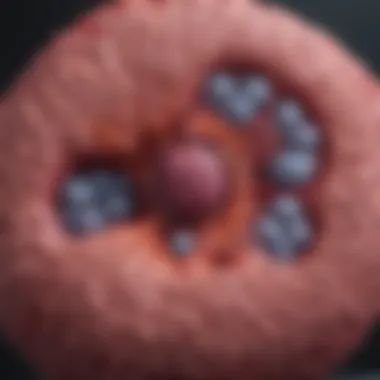Understanding Pancreatic Adenocarcinoma and ICD-10


Intro
Pancreatic adenocarcinoma, a predominant form of pancreatic cancer, poses significant challenges to healthcare professionals and researchers alike. Its aggressive nature and late presentation often result in poor prognoses. Accurate understanding and classification of this disease are crucial for effective patient management and treatment strategies. The International Classification of Diseases, Tenth Revision (ICD-10) serves as a framework for such classifications, affecting everything from diagnosis to epidemiological research. This article will explore the complexities surrounding pancreatic adenocarcinoma and the implications of its ICD-10 classification.
Research Overview
Summary of Key Findings
Research illustrates that pancreatic adenocarcinoma is characterized by a high rate of metastatic disease at diagnosis, commonly involving the liver and peritoneum. The clinical outcomes remain grim, with many patients facing a five-year survival rate of only around 10%. Understanding the nuances of this cancer type can significantly enhance patient care. The proper coding via ICD-10 not only aids in treatment efficacy but also plays a role in public health data collection and analysis.
Research Objectives and Hypotheses
The primary objective of this research is to dissect the classifications provided by the ICD-10 and their relevance in clinical practice. We hypothesize that better awareness of these classifications improves diagnosis and informs treatment options, ultimately enhancing patient outcomes. In addition, we aim to shed light on the repercussions of misclassification in terms of healthcare delivery and epidemiological studies.
Methodology
Study Design and Approach
This exploration employs a qualitative research design, focusing on existing literature regarding pancreatic adenocarcinoma and its ICD-10 coding system. By synthesizing data from various clinical studies, guidelines, and health reports, a comprehensive understanding of the disease and its classification is developed.
Data Collection Techniques
Data sources include peer-reviewed journals, clinical guidelines, and reputable medical databases. Key searches were conducted to find specific coding for pancreatic adenocarcinoma, focusing on category C25 in the ICD-10. This categorization includes aspects such as subtype classification, staging, and associated complications.
"Accurate coding is not just a formality; it influences diagnosis, treatment choices, and epidemiological insights in pancreatic adenocarcinoma."
By collecting and analyzing this data, we present a cohesive narrative that underlines the significance of accurate classification in the management of pancreatic adenocarcinoma.
Epilogue
Understanding Pancreatic Adenocarcinoma
Understanding pancreatic adenocarcinoma is vital for medical professionals, researchers, and students alike. This cancer type not only poses significant challenges in diagnosis and treatment but also has wide-ranging implications within the healthcare system. The insights gained through studying pancreatic adenocarcinoma can improve clinical approaches and enhance patient outcomes.
Furthermore, this understanding is tied to effective coding systems, particularly ICD-10. Accurate coding impacts how healthcare resources are allocated, how research is conducted, and how patients are treated. Therefore, learning about the characteristics and behavior of pancreatic adenocarcinoma is essential for anyone involved in cancer care.
Definition and Overview
Pancreatic adenocarcinoma is a malignant neoplasm that arises from ductal epithelial cells of the pancreas. As the most common type of pancreatic cancer, it accounts for a significant portion of cancer deaths worldwide. The aggressive nature of this cancer means it often presents at an advanced stage, leading to a poor prognosis. Understanding its definition helps in recognizing its clinical manifestations and the urgency in addressing it within the healthcare realm.
Epidemiology
The epidemiology of pancreatic adenocarcinoma reveals critical data affecting public health policy. Globally, the incidence of pancreatic cancer is about 5 per 100,000 individuals. Factors such as geographic location, ethnicity, and family history play a role in its prevalence. It is more common in developed regions, which may reflect lifestyle factors such as diet and smoking.
In terms of mortality, pancreatic adenocarcinoma has a 5-year survival rate of only around 9%. This bleak statistic stems not only from late-stage diagnosis but also from the absence of effective screening methods. Therefore, recognizing epidemiological patterns is crucial for implementing prevention strategies.
Risk Factors
Several risk factors are associated with pancreatic adenocarcinoma. Understanding these can assist in early diagnosis and intervention. Key risk factors include:
- Smoking: This habit substantially increases the risk, with smokers having almost double the chance of developing this cancer.
- Obesity: Higher body mass index (BMI) is linked to increased chances of pancreatic cancer.
- Diabetes: Both Type 2 diabetes and new-onset diabetes can signify an elevated risk.
- Family History: Genetic predisposition plays a role, particularly in syndromes such as hereditary breast and ovarian cancer syndrome.
- Chronic Pancreatitis: Long-term inflammation of the pancreas can elevate the risk of developing pancreatic adenocarcinoma.
These factors highlight the importance of lifestyle and genetic considerations in understanding pancreatic adenocarcinoma, paving the way for preventive measures and targeted research.
Clinical Presentation
The clinical presentation of pancreatic adenocarcinoma is critical in understanding its impact on patient management. Recognizing the signs, staging the disease accurately, and applying appropriate diagnostic imaging techniques play an essential role in the effective treatment of this cancer type. Early detection can significantly influence prognosis and treatment outcomes. Thus, comprehensively understanding the clinical presentation is not just academic; it has real-world implications for patient care.
Signs and Symptoms


Patients with pancreatic adenocarcinoma often present with several signs and symptoms that may vary in intensity and specificity. Many patients experience unexplained weight loss, which can signal an underlying issue. Additionally, abdominal pain, often located in the upper abdomen, is another common complaint. This pain may radiate to the back and could worsen after eating.
Other symptoms include:
- Jaundice: A notable yellowing of the skin and eyes, indicating bile duct obstruction.
- Nausea and Vomiting: These can arise due to tumors affecting the stomach or intestines.
- Loss of Appetite: A decrease in appetite can be linked to various factors, including gastrointestinal distress.
- Fatigue: Chronic tiredness may also occur.
It's important to note that these symptoms are not exclusive to pancreatic adenocarcinoma; hence, a high index of suspicion is essential for timely diagnosis.
Staging of Cancer
Staging is crucial as it determines the extent of the disease, influencing treatment options and prognosis. The most widely used staging system for pancreatic adenocarcinoma is the American Joint Committee on Cancer (AJCC) system, which categorizes the disease into stages I through IV. Each stage reflects how far the cancer has spread:
- Stage I: The cancer is confined to the pancreas.
- Stage II: Tumor may have spread to nearby tissues, but not to major blood vessels or lymph nodes.
- Stage III: Extensive local spread, with involvement of blood vessels and/or regional lymph nodes.
- Stage IV: Distant metastasis is present.
The determination of staging relies heavily on imaging studies and histopathological analysis. Accurate staging not only aids healthcare professionals in deciding therapeutic approaches but also helps in predicting the course of the disease.
Diagnostic Imaging Techniques
Diagnostic imaging techniques are pivotal for an accurate diagnosis and staging of pancreatic adenocarcinoma. Various modalities are utilized, each providing unique insights. Common imaging techniques include:
- Computed Tomography (CT) Scan: Widely used due to its efficiency in visualizing the pancreas and surrounding structures.
- Magnetic Resonance Imaging (MRI): Offers high-resolution images and is particularly valuable for assessing soft tissue in the pancreas.
- Endoscopic Ultrasound (EUS): Allows for detailed imaging and also facilitates biopsy sampling for histological examination.
These imaging techniques can reveal the tumor's size, location, and involvement of adjacent structures, thus playing an essential role in staging and treatment planning.
Understanding the clinical presentation of pancreatic adenocarcinoma through its signs and symptoms, staging, and diagnostic imaging techniques is vital for effective management and intervention. Early recognition leads to better outcomes.
Histopathology
Histopathology plays a critical role in understanding pancreatic adenocarcinoma. It involves the study of the microscopic structure of tissues, which can reveal essential clues about cancer characteristics. This section will discuss the cellular features, molecular markers, and differential diagnosis associated with pancreatic adenocarcinoma, providing a comprehensive guide for better understanding this disease.
Cellular Characteristics
Cellular characteristics of pancreatic adenocarcinoma typically display a range of atypical features. The tumor cells are often ductal in origin, which means they may resemble the pancreatic ducts from which they arise. The presence of poorly differentiated cells is common, indicating a more aggressive nature of the disease.
- Nuclear Pleomorphism: The nuclei of the cancerous cells can vary in size and shape, reflecting the genetic instability present within the tumor.
- High Mitotic Activity: This is indicative of rapid cell division, a hallmark of malignancy.
- Desmoplastic Stroma: The tumor is often surrounded by dense stroma, made of fibrous tissue, which can contribute to its desmoplastic response, complicating treatment options.
The histological classification, including grading, is vital in determining prognosis and treatment strategies. Higher-grade tumors tend to have worse outcomes due to their aggressive behavior.
Molecular Markers
Molecular markers in pancreatic adenocarcinoma offer valuable insights into the disease’s biology. They provide information about the genetic and molecular alterations present in the tumor. Some important markers include:
- KRAS: Mutations in the KRAS gene are found in more than 90% of pancreatic adenocarcinoma cases, making it a central focus for targeted therapies.
- TP53: Alterations in the TP53 gene are also common. This tumor suppressor gene plays a vital role in maintaining genomic stability.
- CDKN2A: The loss of this gene contributes to uncontrolled cell cycle progression.
Identifying these molecular markers can guide therapeutic approaches, enabling personalized medicine tailored to individual genetic profiles. Understanding these markers may also help in predicting responses to certain drugs.
Differential Diagnosis
Differential diagnosis is an essential step in confirming pancreatic adenocarcinoma. Several conditions can mimic its histopathological features, which require careful analysis. Key considerations include:
- Chronic Pancreatitis: This condition can show fibrosis and inflammatory cells similar to those seen in pancreatic cancer, but careful histological examination reveals differences.
- Neuroendocrine Tumors: These tumors arise from the hormone-producing cells of the pancreas and have distinct histopathological features compared to adenocarcinoma.
- Metastatic Cancer: Tumors from other organs that spread to the pancreas may resemble primary adenocarcinoma, making accurate diagnosis crucial.
To differentiate pancreatic adenocarcinoma from these similar conditions, pathologists often use immunohistochemical staining techniques and specialized staining methods to showcase specific features.
Understanding histopathology is not just about identifying cancer but also about making informed decisions about treatment. Accurate interpretation is pivotal in improving patient outcomes.
Thus, mastering the histopathological aspects of pancreatic adenocarcinoma is crucial for the effective identification and management of this malignancy.
ICD-10 Classification


Approaching the classification system for pancreatic adenocarcinoma, a robust structure is pivotal. The International Classification of Diseases, Tenth Revision (ICD-10), serves as a foundational aspect in capturing, reporting, and analyzing health data related to this malignancy. The relevance of ICD-10 lies not just in identifying disease categories but also in facilitating effective communication among healthcare professionals and ensuring appropriate treatment pathways for patients.
The ICD-10 system allows for a detailed classification of diseases, providing unique codes for specific conditions. This specificity is paramount for clinical documentation, billing, and research. By utilizing these codes, healthcare providers can efficiently track disease prevalence, treatment outcomes, and variations in patient care. It also helps in ensuring that patients receive optimized treatment plans tailored to their diagnosis.
Overview of ICD-10 System
The ICD-10 system is an international standard for health information and epidemiological research. It replaces its predecessor, ICD-9, allowing for more comprehensive and detailed classifications. One of its most notable features is the expansion of codes; for example, the ICD-10 includes significantly more codes than ICD-9, which increases the granularity of health data reporting.
In addition to facilitating better data capture, the ICD-10 encompasses a broad range of clinical conditions. It supports health systems in linking diagnoses to treatments, outcomes, and epidemiological data. Overall, this framework enhances both clinical practices and public health initiatives worldwide.
Specific Codes for Pancreatic Adenocarcinoma
The classification of pancreatic adenocarcinoma within the ICD-10 system can be particularly intricate. Specific codes designate different types and stages of pancreatic cancer. The primary code for pancreatic adenocarcinoma is C25.9, which indicates malignant neoplasm of the pancreas, unspecified.
However, there exist several other codes that may be relevant, depending on specific characteristics of the tumor, such as:
- C25.0 - Malignant neoplasm of the head of pancreas
- C25.1 - Malignant neoplasm of the body of pancreas
- C25.2 - Malignant neoplasm of the tail of pancreas
- C25.3 - Malignant neoplasm of the pancreatic duct
Accurate use of these codes is crucial for precise patient care and statistical reporting. Misclassifications can lead to inadequate treatment plans and affect clinical research outcomes.
Importance of Accurate Coding
Accurate coding is a cornerstone in managing the healthcare of patients with pancreatic adenocarcinoma. Proper codes enhance the ability to track disease incidence, manage care protocols, and provide insights into treatment efficacy. With the correct classification, researchers can collect reliable evidence for epidemiological studies.
Moreover, accurate coding impacts financial aspects, such as insurance claims, which can directly influence a patient’s access to treatments. Inaccurate coding can lead to inappropriate reimbursements, which may create barriers to care for patients needing urgent interventions.
In summary, the ICD-10 classification of pancreatic adenocarcinoma underscores its importance in guiding clinical decisions and shaping health policies. Rigorously applied coding practices ensure that the complexities of patient care are met with suitable attention and precision.
"The significance of ICD-10 transcends mere classification; it embodies a critical tool for enhancing patient outcomes and healthcare systems alike."
By observing these coding principles, healthcare professionals can advocate for better management strategies and interventional research focused on pancreatic adenocarcinoma.
Treatment Options
The importance of treatment options in the management of pancreatic adenocarcinoma cannot be understated. This aggressive cancer type requires a tailored approach to therapy due to its unique biological behavior and the complexity of patient presentations. Understanding the variety of treatment modalities is crucial for optimizing patient outcomes and improving survival rates. For healthcare professionals, knowledge of available options guides decision-making, while for patients, awareness of treatment pathways can alleviate anxiety and foster trust in their care teams. Each treatment type carries distinct benefits, considerations, and potential side effects that must be thoroughly evaluated.
Surgical Interventions
Surgical resection remains the only curative option for pancreatic adenocarcinoma in cases where the cancer is localized and resectable. The primary surgical procedure performed is the Whipple procedure, also known as pancreatoduodenectomy. This operation involves the removal of the head of the pancreas, duodenum, gallbladder, and a portion of the bile duct. In select cases, distal pancreatectomy may be indicated, which removes the body and tail of the pancreas.
Key factors influencing the feasibility of surgical interventions include the tumor's size, location, and resectability. Furthermore, imaging studies are critical to evaluate these factors preoperatively.
Potential complications from surgery include:
- Infection
- Bleeding
- Delayed gastric emptying
Ultimately, effective surgical treatment can significantly enhance survival rates and provide a chance for long-term remission.
Chemotherapy Protocols
Chemotherapy plays a pivotal role in the treatment of pancreatic adenocarcinoma, especially for patients with advanced disease. The chemotherapy regimens commonly include FOLFIRINOX, which combines fluorouracil, leucovorin, irinotecan, and oxaliplatin, and Gemcitabine-based therapies, usually given alone or in combination with nab-paclitaxel. These regimens aim to reduce tumor size and control disease progression, allowing patients to become candidates for surgical intervention if possible.
Benefits of chemotherapy protocols include:
- Potential to shrink tumors before surgery (neoadjuvant therapy)
- Prolongation of life in advanced stages
- Relief of symptoms associated with tumor burden
However, adverse effects such as nausea, fatigue, and myelosuppression necessitate close monitoring and supportive care.
Radiation Therapy


Radiation therapy is primarily used in the management of pancreatic adenocarcinoma in specific scenarios. It is often used as an adjunct to surgery or chemotherapy, aimed at eradicating remaining cancer cells. Stereotactic body radiotherapy (SBRT) is a newer technique that delivers high doses of radiation precisely to tumors while sparing surrounding healthy tissue.
The role of radiation therapy includes:
- Post-operative treatment to reduce recurrence risk
- Palliative care for symptomatic relief in advanced cases
Radiation is generally well-tolerated, but potential side effects include fatigue and localized skin irritation. Continuous advancements in techniques and protocols seek to enhance outcomes.
Accurate selection of treatment options not only influences survival outcomes but also impacts the overall quality of life for patients with pancreatic adenocarcinoma.
Emerging Research
Emerging research in the field of pancreatic adenocarcinoma holds paramount importance, especially as the understanding of this aggressive disease continues to evolve. As researchers delve deeper into the underlying mechanisms of this cancer, the findings can significantly impact therapeutic strategies, enhance patient outcomes, and illuminate potential pathways for early detection and intervention. The complexities inherent in pancreatic adenocarcinoma necessitate rigorous investigation and innovation.
Clinical Trials
Clinical trials serve as the backbone of research development in pancreatic adenocarcinoma. These trials assess the safety and efficacy of new treatment modalities, providing crucial data that can lead to regulatory approvals and clinical use. For instance, ongoing trials exploring novel chemotherapeutic agents show promising results. These include combinations of immunotherapy and targeted therapy, which could potentially improve survival rates compared to traditional treatments.
Moreover, clinical trials allow patients access to cutting-edge therapies that are not yet widely available. Participation in these trials can offer a chance for patients to receive the latest advancements in treatment. Patients often benefit from close monitoring and comprehensive care that is part of the trial process. However, it is vital to communicate potential risks and benefits clearly, ensuring informed consent.
Novel Therapeutics
The landscape of therapeutics targeting pancreatic adenocarcinoma is gradually expanding, driven by the need for more effective treatment options. Research into novel therapeutics encompasses a variety of approaches, from molecular targeted therapies to immunotherapies. Drugs that inhibit specific molecular pathways involved in tumor growth have shown potential in preclinical studies.
Immunotherapies, such as checkpoint inhibitors, aim to enhance the body’s immune response against cancer cells. Preliminary results from clinical trials suggest that these innovative treatments could be effective, especially when used in conjunction with other therapies. There are also advancements in personalized medicine, tailoring treatment options based on the individual’s genetic makeup and the molecular profile of the tumor.
Impact of Coding on Healthcare
The impact of accurate coding in healthcare cannot be overstated. In the context of pancreatic adenocarcinoma, this importance escalates due to the disease's complex nature. Proper coding, especially with the ICD-10 classification, is fundamental for ensuring that patient care is fully optimized. The repercussions of misclassification can ripple through the healthcare system, affecting clinical outcomes, healthcare policy, and research prioritization.
Influence on Patient Care
Effective coding directly influences the quality of patient care provided. When pancreatic adenocarcinoma is accurately coded, it enhances treatment planning and patient management. Physicians rely on precise coding for various reasons:
- Treatment Protocols: Accurate coding streamlines treatment pathways. It helps in identifying the appropriate therapeutic options based on the specific cancer type and stage.
- Comorbidity Management: Proper classification allows providers to consider existing comorbidities, tailoring interventions accordingly. For instance, a patient with pancreatic adenocarcinoma and diabetes may necessitate a combined management strategy, improving outcomes.
- Monitoring and Follow-Up: Coding aids in tracking a patient’s journey post-diagnosis. With the right codes, healthcare facilities can effectively set up systems for ongoing care, ensuring that patients receive timely interventions as needed.
"Accurate coding is not just a clerical task; it is a cornerstone for effective patient management and continuity of care."
Quality of Epidemiological Data
The accuracy of epidemiological data hinges on the quality of coding in healthcare. Data derived from correctly classified cases of pancreatic adenocarcinoma is integral for various stakeholders, including researchers, public health officials, and policy makers. Here are key aspects:
- Resource Allocation: Public health resources can be optimally allocated when the prevalence and incidence of pancreatic adenocarcinoma are accurately reported.
- Trend Analysis: Researchers can better analyze trends over time, identifying risk factors and outcomes associated with the disease. This analysis is instrumental in fostering community health initiatives.
- Clinical Research: Robust epidemiological data informs clinical trial designs. When pancreatic adenocarcinoma cases are accurately coded, it ensures that participants in trials represent the actual patient population.
Policy Implications
The implications of accurate coding stretch into policy development. Policymakers utilize the data collected from coding to make informed decisions about healthcare systems. Key points to consider include:
- Funding Decisions: Coding impacts how governmental and private agencies allocate funding for pancreatic cancer research and treatment programs.
- Healthcare Access: With accurate classification, policies can be tailored to improve healthcare access for populations disproportionately affected by pancreatic adenocarcinoma.
- Public Health Initiatives: Good quality data derived from precise ICD-10 coding can lead to more effective public health campaigns aimed at awareness and early detection.
In sum, the impact of coding on healthcare, particularly in relation to pancreatic adenocarcinoma, is profound. Accurate coding not only supports better patient care, enhances the quality of epidemiological data, but also drives significant healthcare policy decisions.
Culmination
Summary of Key Insights
Pancreatic adenocarcinoma presents a unique challenge due to its aggressive nature and often late diagnosis. Some key insights include:
- Epidemiology: The increasing incidence rates and the typical demographics affected by this cancer must be clearly understood. Regions with higher prevalence often display specific risk factors.
- Diagnosis and Staging: Accurate imaging techniques and staging protocols are crucial for determining the most effective treatment plans. Interventions can vary widely between patients, influenced by disease progression.
- Importance of ICD-10: Proper coding in the ICD-10 not only facilitates patient care but also ensures accurate epidemiological data, which is essential for effective public health policies.
By recognizing these insights, healthcare professionals can enhance their approach to managing pancreatic adenocarcinoma, ultimately improving patient outcomes.
Future Directions
As we look to the future, several areas warrant attention:
- Innovative Research: Continued exploration in molecular and genetic studies about pancreatic adenocarcinoma could lead to novel therapies. There are many clinical trials underway that may alter current treatment protocols.
- Refinement of ICD Codes: Updating and refining ICD-10 codes to better reflect the nuances of pancreatic adenocarcinoma, along with ongoing education for healthcare providers, can mitigate errors in classification.
- Patient-Centric Initiatives: Developing programs that inform patients of their condition and treatment options will empower them in their care journey, potentially improving adherence to therapies.















